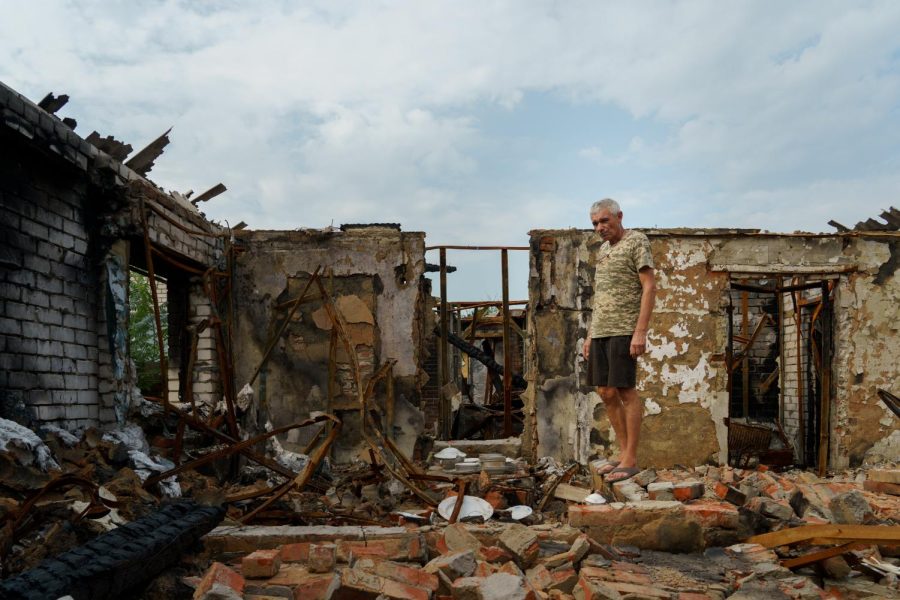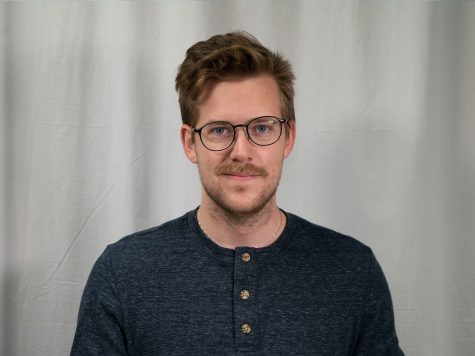Editor’s Note: To protect the privacy of several individuals, some names in this story have been changed.
I distinctly remember when I heard my first bomb. It sounded so similar to thunder, I thought. The explosion cut through the air exactly the same way, the vibrations worming their way inside of my skull, the sound dull and sharp at the same time.
I had just stepped off the train in Kharkiv, the morning sun beginning to bathe the square in front of the station in soft, yellow light. My vest, which I had purchased for its advertised resistance to artillery shrapnel, weighed on my chest and shoulders. My ballistic helmet sat snugly atop my head, a “MEDIA” sticker purchased from Etsy beginning to peel from its rough surface.
Not one of the dozens of people wandering the square gave me a second glance, but I felt thoroughly out of place. Nobody else wore any protective equipment, barr the heavily armed soldiers who stood in the periphery smoking cigarettes. The roar of a distant explosion consumed the entire square, the sound volleying between the tall, wide buildings surrounding it, but not even the pigeons took flight.
________________________
My path to Kharkiv started two months prior, in June of 2022. I’d been taking photographs since 2017, and made it a point to take on the most challenging assignments available to me. Working for Santa Rosa Junior College’s Oak Leaf publication gave me my first real access to the world of photojournalism.
I quickly became comfortable with protests and fires as my working environment. Enamored with the work of conflict and disaster journalists like Lynsey Addario and Daniel Berehulak, I was trying to build a base that could propel me into that dangerous and challenging world.
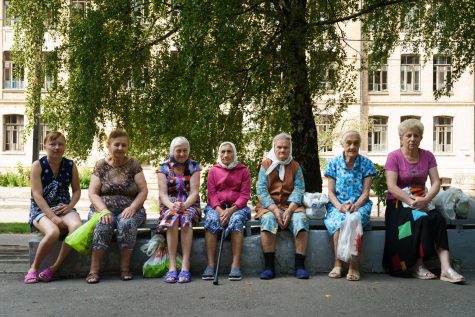
I’d been following the invasion of Ukraine since February but being fresh in the photojournalist world, barely on my first real internship, meant I lacked experience, connections and resources. I did not have the money to hire fixers, the experience to convince publications to send me into dangerous areas, or the popularity to garner sponsors. I was just a young man from a community college who’d started late in his career field.
But these things hadn’t stopped me so far. When a fellow student told me the trains and buses across the Polish border were back up and running, I immediately began planning a trip. I purchased a plane ticket to Poland, blocking out the only two free weeks I had in the summer months. I navigated Polish and Ukrainian railway websites to purchase train tickets in and out of Kyiv. I furiously researched protective equipment before placing an order for a ballistic helmet and vest. Ballistic plates were in short supply due to the war, so I purchased a second-hand pair on Facebook marketplace.
I joined local Ukrainian facebook groups, posting about my trip and making connections with immigrants, expats and first-generation Americans. My two weeks began to take shape. Kyiv as my home base. Trains and buses as transportation. Three stories to pursue: an organization in Chernivtsi rehoming elderly refugees, a nonprofit drone team rescuing animals in bombed out suburbs, and 24 hours with a volunteer team in Ukraine’s largest front-line city: Kharkiv.
________________________
After loading into a van with the team of local volunteers, I was given an introductory drive around Kharkiv. The city sprawled, an expanse of soviet architecture connected by wide veins of freeways and avenues. Every few minutes, the driver would point out the window, pull his cigarette from his mouth and mumble in Ukrainian. “подивіться там.” “Look there.” Without fail, he knew where every single bomb had fallen on our route. Entire buildings had been vaporized, offices, grocery stores, apartments.
Sometimes the rubble had been cleared away; other explosions had happened so recently, clean up crews hadn’t had the chance. Citizens still frequented the sidewalks in front of decimated buildings. Those who were going to flee the city had long since left; those who stayed had long since grown accustomed to the destruction, just as they’d grown accustomed to the constant sound of the bombs.
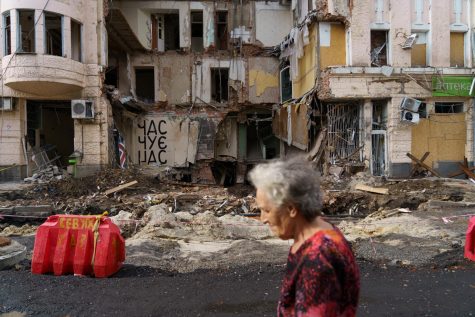
I stood in front of an apartment building, looking up at the collapsed section. A missile had obliterated entire portions of the massive Soviet-style complex, reducing entire apartments to heaps of concrete, leaving only hallways that opened into hundred-foot drops. I pointed my camera up to take a photo and found my lens wasn’t wide enough to fit the destruction in the frame. I turned and took steps toward the edge of the gravel pathway where we parked, planning to step into the brush to achieve my framing.
A stern command came from behind me. “Stop.”
I froze, turning to see my translator, Mira, approaching. A volunteer who left her home country to come to Ukraine, Mira had been my lifeline during my time here so far. She was a serious-faced woman with sharp, modelesque features and jet black hair. In the short time I’d known her, I’d learned to listen intently to her every word.
“What’s wrong?” I asked. She calmly stood on the edge of the gravel pathway with me.
“Do not go into the brush. The Russians use cluster mines,” she said. “A woman last week was killed when she wandered into the bushes.”
I looked out into the lush green brush in front of me, imagining a mine perfectly obscured under soil and vegetation.
Another explosion cut through the air. It was louder than the previous blasts, the vibrations traveling through my chest. Mira shouted something to our driver, then turned back to me.
“We need to go. The bombs are getting closer,” she said.
Piling back into the van, our driver, a volunteer by the name of Slava, began to chat with my translator. We peeled out onto the freeway, and Mira leaned up and over the front row of seats from the back.
“Slava says he could show you the village he grew up in for our last stop,” she said to me. “Would you like to see it?”
________________________
Malaya Rohan is a small village on the outskirts of Kharkiv. As you get farther from the city center, the sprawl cedes ground to the countryside. Apartments are replaced by pastures; skyscrapers by rolling hills and trees. A single road leads to Malaya Rohan.
Two children in army fatigues and toting toy rifles guarded the entrance. They ran down the road with their German Shepherd, Slava playfully hassling them in Ukrainian. They told us that to get into the village, everyone in the car had to say the passphrase, “слава україні.” Glory to Ukraine.
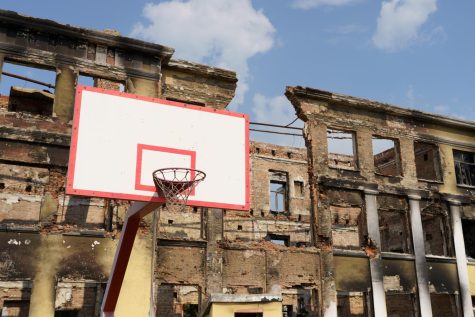
We pulled up in front of Slava’s childhood home. Out stepped his mother, Nadegda, an elderly but spry woman with snow white hair who reminded me of my aunt. She stopped to feed two stray kittens wrestling in her garden before doting on her son. Mira was smitten by the strays and crouched down to play with them. I joined her.
For a blissful moment, everything was peaceful and safe. But a distant explosion brought me back, and I was drawn to the skeletal remains of Nadegda’s garage. Ironically, it looked identical to the remains of structures burned by the fires that ravaged my own hometown of Santa Rosa. Mira, holding a stray kitten, translated Nadegda’s words for me.
Malaya Rohan was invaded by the Russian military early in the war. To take over the area, the Russians conducted a wave of shelling that decimated many of the homes. The residents spent more than a month under Russian occupation, before the Ukrainian military drove them out with an artillery campaign of their own, further damaging the village. As they retreated, the Russians shelled the town one last time, as a parting cruelty.
Nadegda is not sure if her garage or her neighbors’ homes were destroyed by the Russians or her own countrymen. But she was grateful to be out from under Russian occupation, and she was happy her son was safe.
Across the street, a man was outside harvesting apples from his orchard. Huge trees towered above him, and he used a long, hooked pole to pick the highest fruit. His name was Oleksander, a jovial elderly man who gleefully offered us his garden harvest. He motioned for us to follow him into his yard, where he showed us a large hole blasted into the side of his house.
“Подивіться! Подивіться!” he said. “Look! Look!”
He approached a crater, where the back end of a missile protruded from the ground, buried up to its fins. “That’s a missile that landed in his yard and didn’t explode,” Mira translated for me. With a large grin on his face, Oleksander kicked it with a sandaled foot. Mira and I took a large step backwards, both of us nervously laughing at the gall of this shirtless man, surely somebody’s grandfather, kicking a live missile with no fear.
Oleksander told us of another man in the village whose home was not shelled, but burned down by occupying Russians. We made our way to that address, knocking on the heavy steel gate. It slowly slid open, revealing a tan, middle-aged man named Hennadyi.
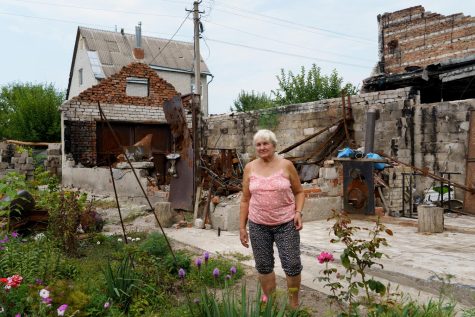
Mira introduced us, and he took us into his property. His home was a pile of bricks and ash, and he lived with his wife in the only remaining structure: a small shed. Russian soldiers discovered his son was a Ukrainian soldier and burned down Hennadyi’s house in a cruel act of vengeance.
He showed us a collection of missile parts and shrapnel he collected and kept as evidence of war crimes. He sent us off with well wishes, shaking my hand and hugging Mira as a thanks for talking with him.
In the middle of Malaya Rohan sat a destroyed Russian tank, the unlucky recipient of a Ukrainian shell. Vegetation was beginning to reclaim it. Nearby, an elderly man picked through a pile of rubble.
Mira and I approached, and he introduced himself as Vasylyi. He motioned for us to follow him through the rubble pile, back to his home. “He says not to worry,” Mira said. “He has already cleared all of the trip grenades left behind by the Russians along this route.”
He showed us his home, heavily damaged, but still standing. Half of his roof was missing, the hole covered by a blue tarp. His two dogs mobbed us as we entered his front yard, licking our hands as we walked by.
He took us to his basement, loaded with non-perishables and survival essentials, where he, his wife, children and grandchildren spent the month the village was under Russian occupation. He pointed to six holes in the door that separates his shelter from the outside, where shrapnel from a shell punctured the heavy steel as if it were nothing but a tarp. His grandchildren’s toys lay in the corner of his attic, left behind when his family fled the village post occupation.
A voice emanated from the street outside Vasylyi’s home, and Mira turned to me, telling me it was time to go. I thanked Vasylyi for his hospitality, and he let me pet his dogs one more time before we left.
Slava had pulled the van around and I hopped back into the front seat, watching the sun fade from the countryside as we drove back into Kharkiv, where bombs continued to echo between the city buildings. Mira hugged me goodbye and Slava took a selfie with me for Instagram.
I made it back to the station — the same square where I’d started my journey in Kharkiv — climbed into the Soviet-era train, and assembled my bed. The sun had just dipped below the green hills and the explosions grew more and more distant. I drifted to sleep, barely aware of the train attendant stepping in to close my window shade, preventing the light from the cabin from attracting artillery fire.
________________________
A distant, low booming woke me from my sleep. My first thought was, “Where am I?”
Weeks of sleeping between trains and hotels made it hard to keep track, but adrenaline forced the sleep from my body and replaced it with panic. Another boom rocked the room as artificial light drifted through the curtains from the skyline and bathed the room in a ghostly yellow glow.
My memories returned: I’d made it back from Kharkiv and was in my rented room. The yellow glow was punctuated by a burst of light, and shortly after, another boom, louder than the first two. I rolled off of the rigid mattress and swiftly crossed the room to the terrace, snatching my helmet off of the couch.
Cautiously, I opened the sliding door. A wall of heat enveloped my body, the humid summer air instantly suffocating my pores.
Warm rain came down hard, and dark clouds obscured the moon and stars. Another flash illuminated the skyline and its trailing boom shook the windows of my small flat.
I curled up on the edge of the terrace, too alert to return to sleep. I watched as a thunderstorm descended onto the city, thunder clapping loud above the Ukrainian capital.
As the storm passed over Kyiv, I thought how similar bombs sound to thunder.



